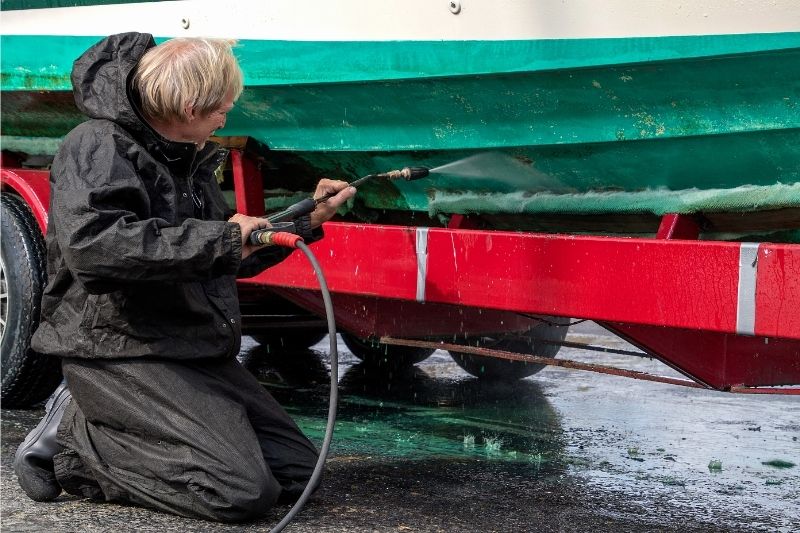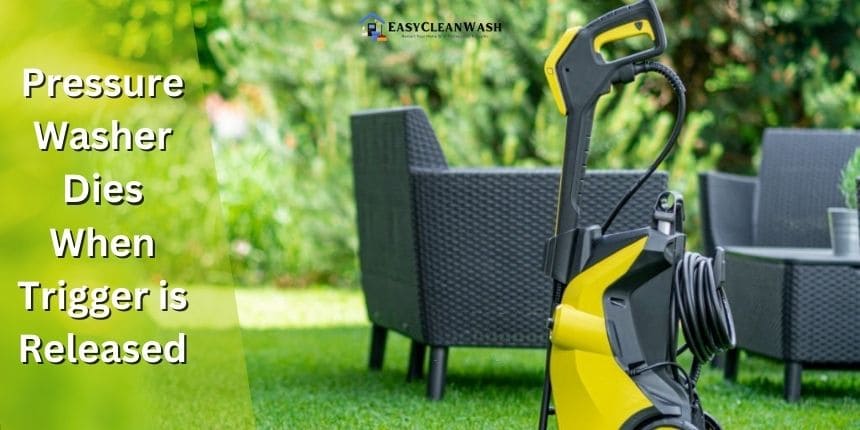I was recently pressure washing my deck and, halfway through, the pressure washer died when I released the trigger. After doing some research, I discovered that this is a common problem with pressure washers. If you’re having this issue, there are a few things you can try to get your pressure washer working again.
If your pressure washer dies when you release the trigger, there are a few things that could be causing the problem. First, check to make sure that the spark plug is clean and in good condition. If it looks dirty or damaged, replace it with a new one.
Next, check the air filter to see if it’s clean. If it’s clogged, replace it with a new one. Finally, check the fuel line to see if there’s any blockage.
If there is, clear it out and try again.
Page Contents
- 1 Pressure Washer Unloader Valve
- 2 Pressure Washer Dies under Load
- 3 Pressure Washer Unloader Valve Adjustment
- 4 Briggs And Stratton Pressure Washer Unloader Valve Location
- 5 Troy Bilt Pressure Washer Unloader Valve
- 6 How to Release Pressure from Pressure Washer
- 7 Craftsman Pressure Washer Unloader Valve
- 8 Pressure Washer Throttle Problems
- 9 -What are Some Common Causes of a Pressure Washer Dying When the Trigger is Released
- 10 Conclusion
Pressure Washer Unloader Valve
If you have a pressure washer, then you know that the unloader valve is an important part of keeping your equipment running smoothly. The unloader valve regulates the flow of water from the pump to the nozzle, and it also relieves pressure when the trigger is not being pulled. This can be a vital piece of equipment for those who use their pressure washers on a regular basis.
If you are having problems with your unloader valve, there are a few things that you can do to troubleshoot the issue. First, check to make sure that there is no debris or buildup in the valve itself. If there is, then you will need to clean it out before proceeding.
Next, check the O-rings on both sides of the valve to see if they are damaged or worn out. These can be replaced easily if necessary. Finally, if all else fails, you may need to replace the entire valve assembly.
Unloader valves are an important part of pressure washers, and they should be cared for accordingly. By following these simple tips, you can keep your unloader valve working properly for years to come!
Pressure Washer Dies under Load
If your pressure washer dies under load, it could be due to a few different issues. The most common cause is that the engine is starved for air. This can happen if the air filter is dirty or if the exhaust isn’t able to vent properly.
Another possibility is that the fuel system is restricted. This can be caused by a clogged fuel filter or a bad fuel pump. If you suspect this is the problem, you should check the fuel lines and filters for any blockages.
Finally, it’s possible that the engine itself is simply worn out. If your machine is older or has been used extensively, it may need to be replaced.
Pressure Washer Unloader Valve Adjustment
One of the most important maintenance tasks you can perform on your pressure washer is to adjust the unloader valve. This simple task can help keep your machine running smoothly and prevent costly repairs down the road.
The unloader valve is responsible for releasing the pressure when the trigger is not engaged.
If this valve becomes stuck in the open position, it can cause water to leak from the pump and reduce the overall life of the machine. Additionally, an improperly adjusted unloader valve can lead to decreased performance and increased wear on pump components.
To properly adjust your pressure washer’s unloader valve, start by disengaging the trigger and release any pressure that may be building up in the system.
Next, locate the adjusting nut on top of the valve body and turn it clockwise until snug. Once tight, turn the nut counterclockwise 1/4 to 1/2 turn to achieve proper adjustment. Finally, re-engage the trigger and test for proper operation before continuing use.
Briggs And Stratton Pressure Washer Unloader Valve Location
If you have a Briggs and Stratton pressure washer, then you know that it is a reliable and powerful machine. However, like all machines, it needs regular maintenance to keep it running smoothly. One of the most important parts of your pressure washer is the unloader valve.
This valve helps to regulate the amount of water that flows through the pump and into the hose. If this valve becomes damaged or dirty, it can cause problems with your pressure washer. In this blog post, we will show you how to find and clean your Briggs and Stratton pressure washer unloader valve.
The first step is to locate the unloader valve on your pressure washer. This valve is usually located near the pump or on the back of the unit. Once you have found the valve, you will need to remove any debris or dirt that may be blocking it.
You can use a brush or compressed air to remove any build-up on the valve.
Once the valve is clean, you will need to check that it is working properly. To do this, turn on your pressure washer and let it run for a few minutes.
Then, turn off the unit and disconnect the hose from the pump outlet port. Next, place your thumb over the inlet port of the unloader valve and turn on the power again. If water starts flowing out ofthe inlet port, then your unloader valve is working correctly.
Troy Bilt Pressure Washer Unloader Valve
If your Troy-Bilt pressure washer isn’t building up pressure, the unloader valve may be to blame. This valve is responsible for redirecting water flow when the trigger is released, and it’s easy to adjust if it’s not working properly. In this blog post, we’ll show you how to troubleshoot and adjust the unloader valve on your Troy-Bilt pressure washer.
If your pressure washer isn’t building up pressure, the first thing you should check is the unloader valve. This valve is responsible for redirecting water flow when the trigger is released, and it’s easy to adjust if it’s not working properly. Here’s how to troubleshoot and adjust the unloader valve on your Troy-Bilt pressure washer.
First, make sure that there is no debris or build-up in the valve itself. If there is, clean it out with a toothpick or other small object. Next, check that the O-ring seal on the valve is intact and in good condition.
If it’s damaged or missing, replace it with a new one. Finally, tighten or loosen the adjustment screw on the side of the valve until the pressure builds up properly when you pull the trigger.
If you’re still having trouble after adjusting the unloader valve, there may be an issue with another component of your pressure washer.
Check our blog for more troubleshooting tips!
How to Release Pressure from Pressure Washer
If you’re like most people, you probably don’t think much about your pressure washer until it’s time to use it. But when you do need to use it, you want to make sure that you know how to release the pressure from the machine properly. Here are some tips on how to do just that:
1. First, turn off the power to the pressure washer. This is an important safety step that should never be ignored.
2. Next, disconnect the hose from the pump.
Once again, this is for safety reasons and will help prevent any accidental releases of pressure while you’re working.
3. Now, open up the valve that releases the pressure from the pump. You’ll usually find this valve near the top of the pump unit.
Slowly turn it counterclockwise until all of the pressure has been released from the system.
4. Finally, close off the valve and reattach the hose to the pump unit. Your pressure washer is now ready for storage or its next use!
Craftsman Pressure Washer Unloader Valve
If you have a Craftsman pressure washer, then you know that the unloader valve is an important part of the machine. This valve helps to regulate the amount of pressure that is being applied to the water as it exits the pump. If this valve becomes damaged or wears out, it can cause your pressure washer to lose power and performance.
In this blog post, we will take a look at how the unloader valve works and what you can do to keep it in good working condition. The unloader valve is located between the pump and the nozzle. When the trigger is released, this valve opens and allows water to flow back into the pump.
This relieves pressure on the system and prevents damage to the pump. The unloader valve also has an adjustable knob that allows you to control how much water flows back into the pump. If this knob is turned too far clockwise, it can cause your pressure washer to lose power.
Conversely, if it is turned too far counterclockwise, your pressure washer may not start at all. To keep your Craftsman pressure washer in good working condition, be sure to check the unloader valve regularly for wear and tear. If you notice any damage, replace the valve immediately.
Also, be sure to keep the adjustment knob in proper working order so that your machine performs at its best.
Pressure Washer Throttle Problems
If you’re having pressure washer throttle problems, there are a few things you can check. First, make sure the choke is in the correct position. If the engine is cold, the choke should be on.
If the engine is warm, the choke should be off.
Next, check the fuel level. If the tank is empty, it’s time to refuel.
Be sure to use fresh gasoline – old gas can cause starting and running problems.
If those things don’t solve the problem, it’s probably time to take your pressure washer to a qualified repair person.

Credit: www.gardentoolexpert.com
-What are Some Common Causes of a Pressure Washer Dying When the Trigger is Released
If your pressure washer is dying when the trigger is released, it could be caused by a few different things. First, check to see if the spark plug is fouled or damaged. If so, clean or replace it.
Next, check the air filter to see if it’s clogged. If it is, clean or replace it. Finally, check the fuel filter to see if it’s dirty or blocked.
If so, clean or replace it.
Conclusion
If your pressure washer dies as soon as you release the trigger, there are a few things you can check. First, make sure that there is gas in the tank and that the engine is getting enough oil. If those things are fine, then it’s likely that the carburetor needs to be cleaned or adjusted.
You can try cleaning the carburetor yourself, but if you’re not comfortable doing that, you should take it to a professional.

